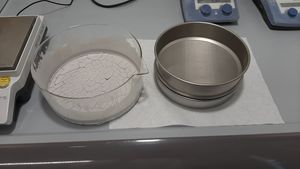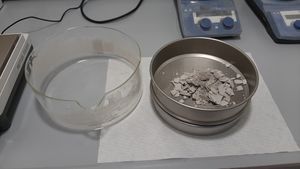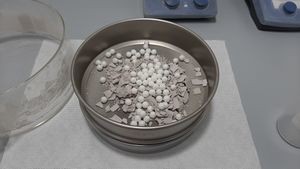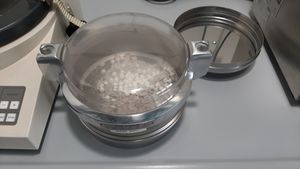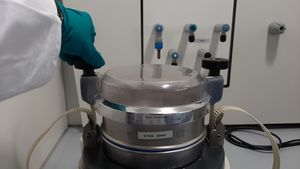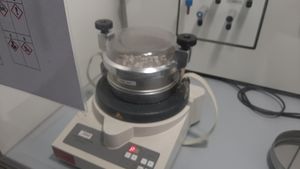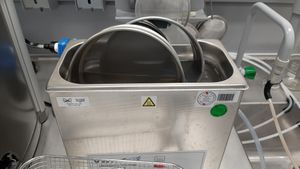Vibrating sieve
A sieve shaker is used to separate powder and grinding balls, crush agglomerates and fractionate a powder into different particle sizes. When equipping a vibrating sieve, a distinction is made between dry sieving and wet sieving. Only dry sieving with a Fritsch Analysette 3 Spartan is described here. Separate sieving equipment should be used for each material in order to avoid cross-contamination. Note that it is difficult to completely clean a technical sieve, so that siving inherently is prone to contamination.
Contents
Construction
It is important for the construction that all seals are present and intact as, otherwise, vibrating a power can contaminate the surrounding atmosphere with powder dust. A sieve lid, a sieve pan and sieve aids are always required to prevent the sieves from clogging. Grinding balls are commonly used as a sieve aid.
Separation of powder and grinding balls
To separate the dried powder and grinding balls, a sieve is selected that has a smaller mesh size than the grinding balls used. If agglomerates are also to be crushed, a sieve with a mesh size corresponding to the desired particle size is used. The amount and size of grinding balls that were used in the previous grinding process are sufficient as a sieving aid. If grinding balls are added for sieving, about the same mass of milling balls as powder is sufficient, and typically, 10mm balls are a good choice.
Crushing agglomerates
To crush agglomerates, the powder is placed on a sieve with a mesh size of 20 µm to 100 µm together with grinding balls as sieving aids. The particle size distribution can be used to decide on the mesh size.
Separation of different particle sizes
If a certain range of particle sizes is required, at least two sieves with a mesh size of the minimum and maximum size are selected. A total of up to five sieves can be used in a sieve tower.
Filling the sieve tower
The top sieve of the sieve tower is carefully filled with the material to be sieved and the sieve aids from a small height in order to avoid damage and dust. A spatula or spoon should not be brushed over the mesh in order not to damage it. If the amount of sieve aids exceeds 300 g, the material must be sieved in portions to avoid damaging the sieves. If the balls from the previous grinding process are not used, 10 mm grinding balls are recommended as additional sieving aids.
Make sure to lock the top tight enough with the two mounting screws, and to close the hood.
Adjusting the amplitude
The amplitude is determined optically via the sieve cover. There are lines at various specified intervals on the sieve cover. The amplitude is increased or decreased via the keypad until the lines of the desired distance are optically one above the other. The optimum amplitude is reached when the sieve aids almost or only very lightly touch the sieve cover. This can easily be heard by clicking noises of the balls hitting the top plate.
Cleaning
Sieving is complete if there is no or only little powder left on top of the sieve. Note that large agglomerates or particles will intentionally not pass the sieve and should be discarded.
After removing the powder from the pan and sieves after sieving, the sieves are first carefully cleaned with water and some dispersant. Hard or pointed objects, such as spatulas or tweezers, should not be used as these will damage the sieve. The sieve is then cleaned in an ultrasonic bath to remove the remaining particles. Finally, the contaminated water from the ultrasonic bath is removed from the sieve by rinsing with water and/or ethanol.

